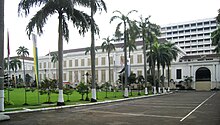Ministry of Finance (Indonesia)
| Kementerian Keuangan | |
 |
|
 The A.A. Maramis Building, the headquarter of the Indonesian Ministry of Finance Building |
|
| Ministry overview | |
|---|---|
| Formed | 19 August 1945 |
| Jurisdiction |
|
| Headquarters | Gedung Djuanda I Jalan Dr. Wahidin Raya No. 1 Jakarta Pusat 10710 Jakarta, Indonesia |
| Ministers responsible |
|
| Website | kemenkeu |
Ministry of Finance is a ministry in Indonesia that hold responsibility on finance and state assets. The ministry is led by a minister and responsible to President. The motto is Nagara Dana Rakça that means guardian of state finance.
Dutch, as Dutch East India Company, was given octrooi to print money at period of Governor General Jan Pieterszoon Coen. Since 17 century, Dutch East India Company was increasing state cash. The company raise state cash by obligation to surrender agricultural product (verplichte leverentie), restriction of agricultural production (contingenten, which increase the price) and obligation to plant strategic agricultural product such as coffee (preangerstelsel).
However, British took over of Dutch East India as part of War of the Sixth Coalition and sent Stamford Raffles as Lieutenant-Governor. Stamford Raffles instituted reformation as land tax (landrent), which changed former Dutch system, to enable the society to buy British product with money. The reform was fail to introduce standardised monetary system because of lack of support from local aristocracy and inadequate society knowledge about money and tax calculation.
After the Napoleonic Wars, Dutch East India was returned to Dutch from British as Anglo-Dutch Treaty of 1814. Governor General Du Bus resumed economic development and established De Javasche Bank as part of financial and payment system reform. In 1836, van den Bosch introduced forced plantation (cultuurstelsel) to produce global-favored product. Forced plantation was replacement to land tax system and had intent to introduce monetary economics to society. Forced plantation and forced labour had sufficient effect to introduce monetary economics.
Government policy was shifted into liberal economics. The policy was implemented as "laissez faire, laissez passer", which economics responsibility is shifted to private sector. Department of Finance (Departement van Financien) was established to co-ordinate, develop and support financial administration. Centralized financial administration was done to make easy management of state revenue and expenditure.
...
Wikipedia
